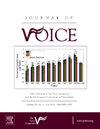歌手口咽几何形状与声学参数之间的关系:初步研究
IF 2.4
4区 医学
Q1 AUDIOLOGY & SPEECH-LANGUAGE PATHOLOGY
引用次数: 0
摘要
目的验证按性别分层的歌手的声像参数和epstral参数与口咽几何形状之间可能存在的相关性:从数据库中检索并分析了 31 名歌手(13 名女性和 18 名男性,平均年龄为 28 (±5.0) 岁)的嗓音记录和口咽测量数据。口咽几何测量是通过声学咽喉测量收集的,语音记录包括持续元音/Ԑ/发音,这些记录被导出到 Praat 软件并进行编辑,以获得按性别分层的共振和倒频谱参数。采用皮尔逊线性相关检验将语音参数与口咽几何形状联系起来,显著性水平为 5%;采用线性回归检验来证明与第二心形相关的变量:仅在口腔长度(男性较大)和咽腔长度(女性较大)方面发现了性别差异。在女性组中,第三次发声与倒频谱之间呈线性相关。在男性组中,倒频谱与第三和第四前元音呈线性相关。在女性组中,咽腔容积与第二阵态之间也存在置信度高达 95% 的正线性相关,因此可以估计第二阵态的回归模型(R2 = 0.70):结论:口咽的几何形状和声像参数与性别之间存在相关性。女性咽腔容积与第二心音的相关性最大。本文章由计算机程序翻译,如有差异,请以英文原文为准。
Relationship Between Oropharyngeal Geometry and Acoustic Parameters in Singers: A Preliminary Study
Objective
To verify possible correlations between formant and cepstral parameters and oropharyngeal geometry in singers, stratified by sex.
Method
Voice records and oropharyngeal measures of 31 singers – 13 females and 18 males, mean age of 28 (±5.0) years – were retrieved from a database and analyzed. The oropharyngeal geometry measures were collected with acoustic pharyngometry, and the voice records consisted of sustained vowel /Ԑ/ phonation, which were exported to Praat software and edited to obtain the formant and cepstral parameters, stratified by sex. The Pearson linear correlation test was applied to relate voice parameters to oropharyngeal geometry, at the 5% significance level; the linear regression test was used to justify the variable related to the second formant.
Results
Differences between the sexes were identified only in the oral cavity length (greater in males) and pharyngeal cavity length (greater in females). There was a linear correlation between the third formant and the cepstrum in the female group. In the male group, there was a linear correlation between the cepstrum and the third and fourth formants. A positive linear correlation with up to 95% confidence was also identified between the pharyngeal cavity volume and the second formant in the female group, making it possible to estimate a regression model for the second formant (R2 = 0.70).
Conclusion
There are correlations between the oropharyngeal geometry and formant and cepstral parameters in relation to sex. The pharyngeal cavity volume showed the greatest correlation between females and the second formant.
求助全文
通过发布文献求助,成功后即可免费获取论文全文。
去求助
来源期刊

Journal of Voice
医学-耳鼻喉科学
CiteScore
4.00
自引率
13.60%
发文量
395
审稿时长
59 days
期刊介绍:
The Journal of Voice is widely regarded as the world''s premiere journal for voice medicine and research. This peer-reviewed publication is listed in Index Medicus and is indexed by the Institute for Scientific Information. The journal contains articles written by experts throughout the world on all topics in voice sciences, voice medicine and surgery, and speech-language pathologists'' management of voice-related problems. The journal includes clinical articles, clinical research, and laboratory research. Members of the Foundation receive the journal as a benefit of membership.
 求助内容:
求助内容: 应助结果提醒方式:
应助结果提醒方式:


